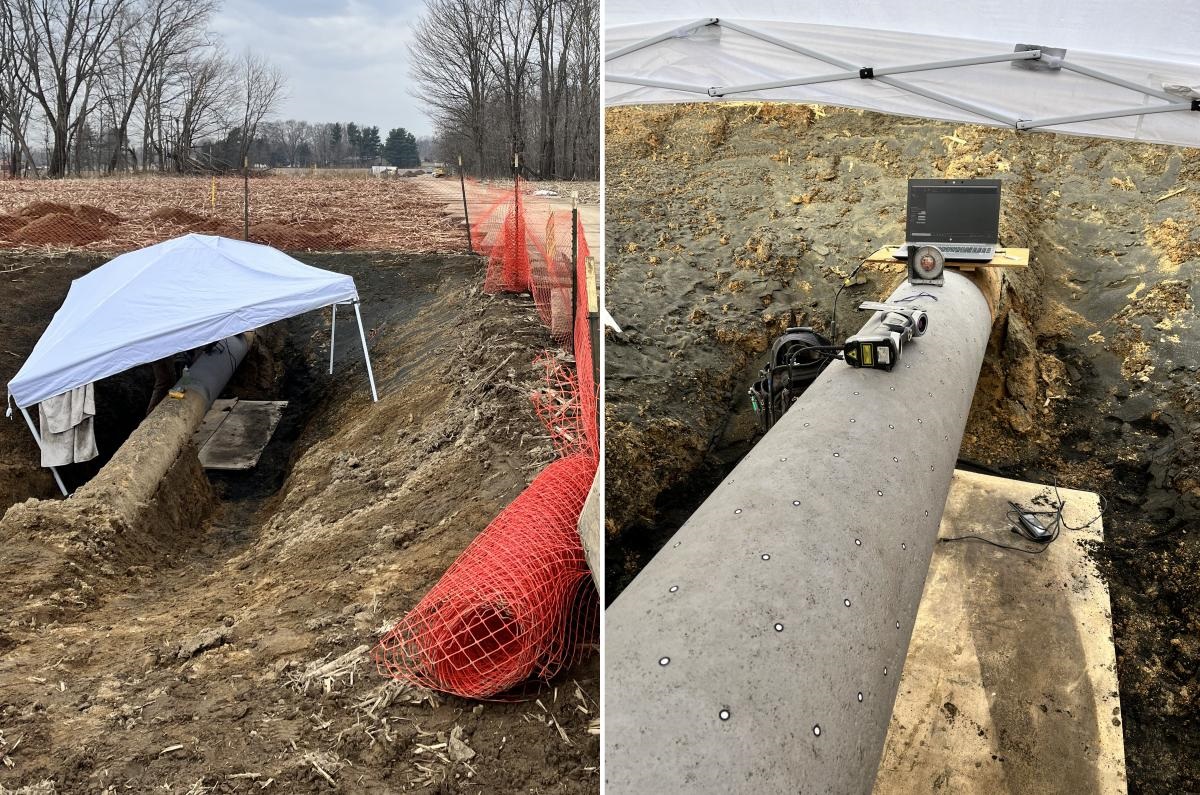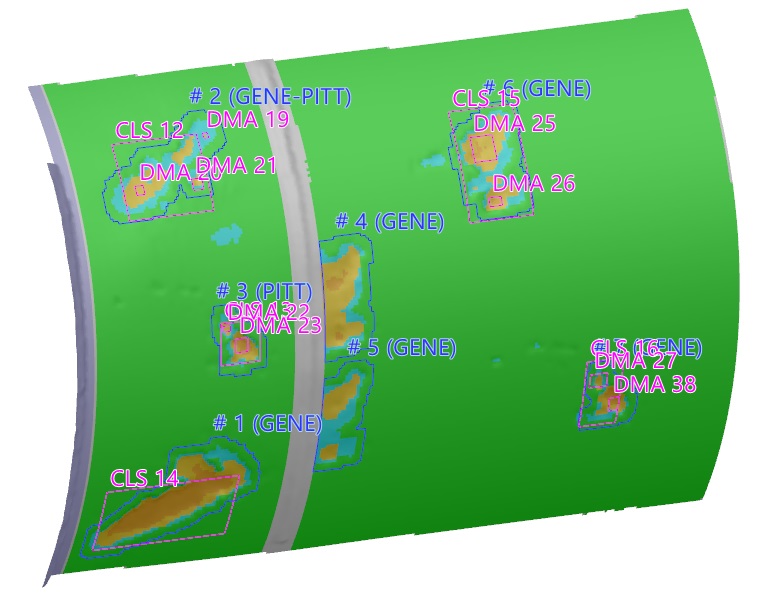- Article
- Related
The economic impact of digging areas in which no critical repairs are needed and omitting areas where potential failures could abruptly occur depends on one factor: the performance of in-line inspection (ILI) techniques. Therefore, it is important to verify the reliability of these ILI tools that use ultrasonic testing (UT) or magnetic flux leakage (MFL) testing to detect and size damages and irregularities in pipelines.
Challenges: How can we ensure the accuracy and reliability of an ILI tool?
ILI tools are helpful. They are relatively accurate at providing information on a pipeline’s health and can effectively spot features requiring assessment and repair. Nevertheless, service companies usually use direct assessment techniques to validate the results obtained from ILI tools (which they refer to as “smart pigs”).
When a smart pig captures data on the surface of a pipe, we calibrate its electromagnetic signal with a standard signal that is similar to the inspected pipe segment. The accuracy of these relative measurements must then be checked through validation inspection because field conditions may differ from calibration conditions, leading to more or less significant errors.
Relative measurements are often influenced by handling errors during calibration, changing environmental conditions, or other differences between the inspected part and the calibration standard. Therefore, calibrating the inspected pipe segment is always ideal for ensuring the accuracy of the relative ILI technique.
Why is it so essential to correlate field data between ILI tools and pit gauges?
To confidently assess, qualify, and validate the performance of ILI tools, service companies spend a lot of time trying to correlate field data between smart pigs and pit gauges (or any other direct assessment tool). Although tedious, this task is essential because pipeline operators commonly compile significant statistical population analyses over multiple cycles with devices offering better absolute accuracy than MFL technology.
How can we correlate two techniques with different resolutions and precisions?
Considering that the ILI and direct assessment tools have neither the same resolution nor the same precision in different axes (i.e., position, depth, circumference), the best option is to choose an integrated solution that enables service companies to correlate these two different techniques in the same intuitive software environment.
Can we be 100% confident in the manual measurements of a pit gauge?
In this quest to ensure better data accuracy and reliability in pipe calibration, the measurement quality must not depend on the technician's abilities. There is already enough pressure on them to complete their inspections quickly while working in harsh environments. They must be fully confident that their measurement technique will produce reliable results independently of how the tool is handled. This is where 3D scanning comes into play.
Solutions: Efficient, Accurate, User-Independent, and Easy-to-Use 3D Scanning Systems with a Pipeline Inspection Software Module
Efficiency: Once the 3D scanner has captured corrosion and dent features, Creaform technology performs ILI correlation between the smart-pig inspection results and 3D scanning data. The Pipeline software module (featured in VXintegrity) associates the scanned results with the data identified by the ILI tool, creates associations automatically when features overlap, and identifies unmatched features. The user interface is optimized to compare features’ depth, length, and width with just one click.
Metrology-grade accuracy: With absolute measurements and results that are repeatable regardless of setup quality, environmental instabilities, and user experience, operators and service companies are sure to get reliable inspection results and digital reconstructions with the highest data quality.
User-independence: When validating the performance of ILI tools, the measurement instrument and method are crucial. Manual methods are known to lack consistency, and the resulting statistical conclusions may be highly questionable. With 3D scanning technology, however, the results are entirely independent of how the measurements are taken and the skill level of the technicians. Service companies are sure to obtain the same unique scan regardless of the technician’s experience, allowing them to proceed with data acquisition and analysis without extensive intervention.
Simplicity: With plug-and-play devices, user-friendly interfaces, preconfigured parameters, and predefined workflows, operators can capture data quickly and reliably. The Pipeline software module even exports Excel reports with visual graphics and tables detailing the ILI and scanning associations, making the process more seamless and straightforward.
VXintegrity’s pipeline module – equipped with the HandySCAN 3D|BLACK Series – provides the only technique available on the market offering metrology-grade accuracy and human-independent results to eliminate measurement variations and ambiguity in result interpretation.
Benefits: With ILI correlation results, NDT service companies now know where to invest their energy
Correlating scanned data and ILI inspection results gives service companies a better picture of the corrosion growth, allowing them to make better decisions and ultimately save time and money.
- Confidence in the ILI correlation results.
Because the Pipeline module monitors ILI performance levels by correlating smart-pig data against pipeline 3D scanning data, correlation results are becoming more accurate. Service companies can know with more certainty which sites they must dig up, reducing the number of excavations necessary for direct assessment and repair.
- Several million saved by preventing unnecessary digs.
An analysis of over 100 ILI indications against field data has found that, while the overall average showed a good correlation, deeper ILI-indicated pits had poor unity with field data. Ultimately, the ILI tool vendor agreed with the analysis and re-graded the report, removing digs that would have cost several million dollars from the repair plan.
- Return on investment
Since the acquisition of simple and accurate technology costing only tens of thousands of dollars can contribute to saving several million on digging, the service company can redirect these savings in time and money to more critical areas that require more attention.
Having the background knowledge and ability to recognize when something doesn’t seem right can save significant amounts of time and expense. HT Engineering's experienced integrity team has always been there to help its customers maximize their efforts on their tool runs and repair plans, saving them large sums of money.
For instance, when a final report showed a significant number of 180-day corrosion features, Jason R. Larman, Project Manager at HT Engineering, was both concerned and curious. Had something occurred to accelerate corrosion significantly? Were previous tool runs under-reporting metal loss? Did the pervasive surface roughness of this older line cause the over-reporting of corrosion features?
Thankfully, he had been previously introduced to Creaform's laser scanning technology, so he and his team decided to contact an NDT company that already had a Creaform 3D scanner and Pipecheck. This company performed the scans on some "easy-to-get-to" locations and provided HT Engineering with the data for analysis.
Their analysis of over 100 ILI indications compared to field data found that, while the overall average showed a good correlation, deeper ILI-indicated pits had poor unity with field data. Ultimately, the tool vendor agreed with HT Engineering's analysis and re-graded the report. The re-grade removed over $4 million worth of digs from the repair plan. Not bad for a $40,000 investment!
NEED MORE INFORMATION ABOUT OUR SOLUTIONS?



